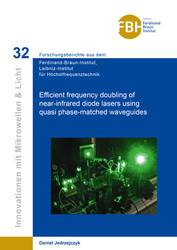| Areas | |
|---|---|
| Serie de libros (96) |
1378
|
| Nachhaltigkeit |
3
|
| Gesundheitswesen |
1
|
| Letra |
2365
|
| Ciencias Naturales |
5406
|
| Matemática | 229 |
| Informática | 319 |
| Física | 980 |
| Química | 1363 |
| Geociencias | 131 |
| Medicina humana | 243 |
| Estomatología | 10 |
| Veterinaria | 108 |
| Farmacia | 147 |
| Biología | 835 |
| Bioquímica, biología molecular, tecnología genética | 121 |
| Biofísica | 25 |
| Nutrición | 45 |
| Agricultura | 1004 |
| Silvicultura | 201 |
| Horticultura | 20 |
| Ecología y conservación de la tierra | 148 |
| Ciencias Ingeniería |
1793
|
| General |
98
|
|
Leitlinien Unfallchirurgie
5. Auflage bestellen |
|
Erweiterte Suche
Efficient frequency doubling of near-infrared diode lasers using quasi phase-matched waveguides (Volumen 32) (Tienda española)
Daniel Jedrzejczyk (Autor)Previo
Indice, PDF (51 KB)
Lectura de prueba, PDF (140 KB)
Single-pass frequency doubling of near-infrared (NIR) diode lasers in nonlinear bulk crystals allows to realize compact lasers in the green spectral region, offering continuous-wave (CW) laser radiation characterized by a high spectral brightness. In order to increase the efficiency of such laser systems, the application of quasi phase-matched waveguide structures instead of bulk crystals is investigated theoretically and experimentally. In particular, a complemented study of second-harmonic generation (SHG) in periodically poled MgO-doped lithium niobate (MgO:LN) ridge and planar waveguides is conducted. This study aims at identifying benefits and limitations for both geometries with respect to maximum conversion efficiency and accessible power.
The application of waveguide structures presented in this thesis results in a distinct improvement of the opto-optical conversion efficiency – from approximately 20 % in a bulk crystal to almost 30 % in a planar waveguide, and to around 40 % in a ridge waveguide. A maximum second-harmonic power of nearly 0.4 W in a ridge waveguide and 1.2 W in planar waveguide is reached. The generated laser radiation in the green spectral range is characterized by a single-frequency spectrum and nearly diffrac-tion-limited beam quality and thus ideally suited for applications in bio-medicine, bio-technology, and spectroscopy.
| ISBN-13 (Impresion) | 9783954049585 |
| ISBN-13 (E-Book) | 9783736949584 |
| Formato | A5 |
| Idioma | Inglés |
| Numero de paginas | 134 |
| Edicion | 1. Aufl. |
| Serie | Innovationen mit Mikrowellen und Licht. Forschungsberichte aus dem Ferdinand-Braun-Institut, Leibniz-Institut für Höchstfrequenztechnik |
| Volumen | 32 |
| Lugar de publicacion | Göttingen |
| Lugar de la disertacion | TU Berlin |
| Fecha de publicacion | 12.05.2015 |
| Clasificacion simple | Tesis doctoral |
| Area |
Física
|








